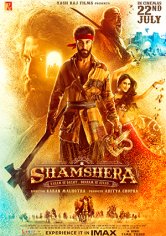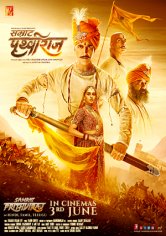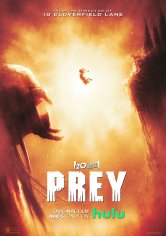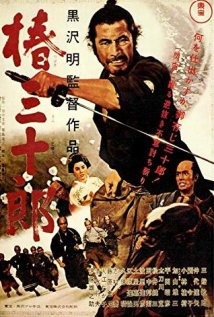Rayting:
8.1/
10 33.5K votes
Language: Japanese
Release date: 1 January 1962
A crafty samurai helps a young man and his fellow clansmen save his uncle, who has been framed and imprisoned by a corrupt superintendent.
Where to Watch
-

Buy
-

Buy
Similar Movies
5.4

Spiderhead 2022
5.0

Shamshera 2022
5.9

Samrat Prithviraj 2022
6.1

Ambulance 2022
8.0

RRR 2022
7.2

Prey 2022
8.4

K.G.F: Chapter 2 2022
7.2

The Northman 2022


User Reviews
Sanjuro is the sequel to Yojimbo. The anti-hero is once again played by Mifune. He is a roaming "masterless samurai" after the Japanese emperor officially disbanded the samurai. Sanjuro's only mission in life is to survive and live by the unspoken samurai code of honor. In both films, it is only by accident that he combat the oppressive. The opening scene in Sanjuro was a long shot of a temple. It was followed by a jump cut, close-up of the same temple. This is a jarring effect that is a pattern of Kurosawa. He used this very same technique in the opening sequence of Rashomon. Kurosawa's superbly sharpen directorial skills are evident in this film. He uses a narrative economy technique that lets the audience dive right into the story without using a long draw-out exposition. The plot and characters are explained within the first five minutes of this film.
The story begins during a samurai meeting in a house. Sanjuro interrupts this meeting. He's been listening to their conversation. The cocky Sanjuro relaxes their guard because he analyzes their situation. He predicts, and is subsequently correct, that they will be ambushed. The group prepares for their certain death. Quickly, Sanjuro devises a plan and boldly states, "trust me" to his cohorts. This excellent delivery from Mifune lets the audience know that this sequel is going to be just as fun (if not better) as Yojimbo. A hilarious character for this film is the captured guard that was spared because of the rescued woman. His role was tiny but very memorable. He was the comic relief for a few of the tense moments. Towards the end of the film, the flower signal scene is super funny. Sanjuro tricks the three goof balls into putting the flowers in the creek. The neighboring samurai rejoice with excitement. Meanwhile, the captured guard shortly joins the celebration but gets a look from the samurai and returns to the closet. This is reminiscent of the three stooges. I really love this scene.
Reoccurring Kurosawa patterns include the use of multiple film planes. An example of this is the scene in the barn. Sanjuro is lying on the wheel barrel. The camera POV is on the floor shooting upwards. The wheel barrel is the first plane, Sanjuro is the middle plane, and the other samurai with their backs against the wall are the third plane. This abstract framing adds to the film's production value. It also breaks up the predictable framing of the characters. Likewise, framing is consistent in this film as in all Kurosawa film's because all of the players are perfectly in view, no actor is excluded from the camera view. Mifune's character finally arches in this sequel because he is told "killing is a bad habit" by the rescued older lady. He is quick to change internally to her wishes. Although Sanjuro is told once again, "please don't use too much violence", Sanjuro's hand is forced. He is "forced to kill" the numerous bad guys that are guarding the three hostage samurai because of their mistrust. He is hard on himself but harder on the three samurai that he slaps. In addition, this scene is reminiscent of Yojimbo. Sanjuro is entrusted with the lives of the "enemy" but instead slaughter his real enemy. Another example of his arched character in this film occurs in the final scene. Sanjuro does not want to fight the banished samurai. Once again, Sanjuro is force into violence. His last words were, "I am just like him, he was like a sword that should have a sheath". This is a c
Fmovies: Sanjuro is another in a long line of purely classic films by Akira Kurosawa. This movie was made on a whim on the heels of the wildly successful Yojimbo, but Kurosawa doesn't simply whip out a movie to satisfy the audience; he creates another film masterpiece. This is a farcical comedy shot with the same brilliance as Ran--take a minute and notice how perfectly the image on the screen portrays what Kurosawa wants us to see. Nothing about this film is a mistake, something that he would want to do over. Watch this film!
Leadership. Sanjuro is able to lead men because he appears confident, and is confident. His presence subjugates men, as a man's presence subjugates boys. We see here how a group comes to have a leader. First one man stands out against him, the competitor for leadership, but Sanjuro's intuition and actions put him ahead. There is a beautiful marked difference between Sanjuro and the men. He is the lazy quiet tiger, seemingly passive yet containing an immense power - a tightly drawn bow. The men are barking puppies, energy spilling over, but to no good end.
Kurosawa presents a couple challenges to the viewer. THere is a terrible absurdity in the killing of all these men, for it becomes quiet clear with the symbol of the prisoner, that the average soldier is a frightened herd animal, not good or evil, but cowardly. Sanjuro recognizes this but has no choice, for he wants to live, and so must kill. Thus he must even kill the young men who he helps, when they foolishly come after him. The prisoner is won over by the old lady - so we see an almost christian ethic. In the tensions of the film one feels that the people, riled up by lies to fight for the enemy, quickly become targets of the just young men's swords - luckily it does not come to this, but one recognizes the horrible possibility and inevitability of such a struggle. Thus we are faced with a critic of war - men, scared like cattle battle under the flag of corrupt leaders, and those that may love them must kill them, if they are not to die by sword, or become slaves to tyrants.
"stupid friends are worse than enemies" For you know who your enemies are, and that they wish to destroy you.
In Sanjuro we also see the soldier, so long in battle that he is unable to live a normal life. He can not wear the house kimoto, he is to bound up in fighting - he is samuri, warrior, and he cannot escape this, much as Achilles cannot return home to Pthia. And we sense Sanjuro must whilt in the easy domestic life, for his is the road of struggle. The pleasant scent of the straw in the barn, the pretty camillias are still able to touch him, but he cannot enjoy them; he is a soldier, and therefore his sensitivities must yeild to the demands of war.
We see only one man worthy standing with Sanjuro, and that is the uncle, the chamberlain, the horseface. These to stand out as burning stars against a massive black sky - the rest is horrifying; the chaos of tyranical men and the fear crazed soldiers, their supplicants.
Sanjuro fmovies. Sanjuro is not one of Kurosawa's great films, but it shows him relaxed and having fun, deconstructing the jidai-geki (samurai film) genre with tongue firmly in cheek.
The film lacks the meticulous visual style of Yojimbo, but it is very well photographed, with some extremely fluid cinematography and those effortlessly artful group compositions that only Kurosawa seems to be able to do. The plot is a little exposition-heavy, but it's always swift-moving and never comes close to taking itself seriously.
Watching Toshiro slice apart all those enemies in the various battle scenes with nary a bloodstain in sight, I did find myself wishing the folks at Toho had sprung for a few squibs. But all is set right in the brilliant final swordfight, which is worth the price of admission.
Sanjuro is the sequel to Yojimbo (1961) and see's our unnamed ronin friend once again defending the innocent under the guise of his own desires.
Toshirô Mifune returns as the grumpy samurai and delivers a strong performance yet again. He is flanked by much of the same cast from the original movie, though they're all playing different characters (Which really damages the movies credibility).
This time he saves the lives of 9 men and joins them in saving one of their relatives. This time however it's more strategy and action than Yojimbos intricate mind games.
Truth be told Sanjuro is a weaker Toho movie than Yojimbo, it isn't as clever and certainly lacks the same level of charm. Regardless however it's a well constructed movie and Kurosawa has done a great job in it's creation.
Alike Yojimbo it sits within IMDB's top 250 movies, presently lower at 222. I don't agree that either of them should be in there, but then again very few should be in my eyes. Kurosawa's pinnacle was Seven Samurai (1954) and from what I've seen thus far I doubt it'll be beaten.
Very watchable Japanese samurai cinema, but hardly groundbreaking.
The Good:
Toshirô Mifune
Has real charm
The Bad:
Sworddplay is still terrible
Inferior to Yojimbo
Things I Learnt From This Movie:
In fuedal Japan, barns were regular love nests
Sanuro, the sequel (or prequel, more likely a sequel though) to Akira Kurosawa's 1961 classic Yojimbo, brings us Toshiro Mifune to one of his most memorable characters, as he helps out (begrudgingly but, for the audience, funny way of help) with a group of would-be samurai trying to fight a corrupt man trying to gain power. With this film, Kurosawa delivers if not more than the same amount of violence (with one of his finest scenes of which towards the very end), and Mifune along with co-stars are believable and make for an entertaining ride. For those who are not familiar with Kurosawa and look to start, this and Yojimbo are the best starting points.
But to say that it is not one of Kurosawa's very best is not entirely a dis-service to him. One flaw for me was that the story was not very clear on the first viewing, or at least as clear as what I'm used to from him (then again, the samurai genre is one I've only started to dig into). But a second viewing brought it clearer, and was even more suspenseful and amusing. That it is not as satirical (or perhaps it is) than what I had heard is not a minus however. The best that can be said that it is highly watchable, and could grow on those looking for a samurai film with more based on character than on immediate, flowing blood-shed and carnage. The least that can be said is that it does not compromise artistry and thoughtfulness for mediocrity. Grade: A